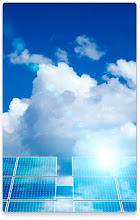When thinking about renewable electricity for your home, two options spring to mind; photovoltaic panels and small wind turbines. But which one should you choose? The government has introduced a feed-in-tariff that pays a subsidized amount for the electricity they produce and the amount paid for small wind turbines is similar to that paid for small PV systems (34p/kWh compared to 41p/kWh).
The key criteria to deciding which technology will be the most profitable is the cost of producing a unit of energy from each one. For this you need to factor in the up front costs such as equipment and installation, and then look at how much energy they will produce once out there over an average year. Without going too heavily into numbers my argument is that in some instances, micro-wind turbines will have a lower cost of energy than solar panels, but for the majority of cases solar panels will be better and this can be explained by some basic science.
Without a doubt, on a large scale, wind energy is cheaper than solar. The cost of energy from large-scale wind farms is somewhere around 10p/kWh whereas the cost of energy from large-scale solar is three to four times greater at present. Big wind turbines are now very well designed products and many years of industry development means that the costs have fallen dramatically and continue to do so. Big solar farms are also rapidly reducing in cost and make a lot of sense in some locations, particularly in the many regions where wind farms are not suitable, but for now they do not compete.
On the small scale however, the economics are drastically different. As the size of a solar installation decreases, the performance falls linearly with the amount of area used, and therefore the cost of energy does not change so dramatically. In contrast, as wind turbines get smaller their performance gets disproportionately worse.
This is for two mains reasons:
The first reason is that as the turbine blade length gets shorter, the ‘swept-area’ decreases quadratically. This means that if you decrease the length of a blade from 80 meters to 40 meters, the area covered by the blade decreases from 20 thousand square meters to just 5 thousand. The ‘swept-area’ determines how much wind energy the turbine can use. So when you decrease the blade length you still need all the expensive moving parts like the generator, but you get disproportionally less energy – for one big wind turbine you would need thousands of smaller ones to cover the same area.
The second reason is that where you use micro-wind turbines the wind speed is generally slower. This is because most of us live in built up areas where there are other buildings nearby. These buildings disrupt the wind, making it irregular and slow. Wind speed is crucial to the effectiveness of a wind turbine, again because the energy contained in the wind is disproportional to its speed. If the wind speed drops by a factor of 2, the energy produced by a wind turbine decreases by a factor of 4. Comparing most built up areas, the average wind speed is much lower than half the wind speed found high-up in open spaces where you find most wind farms.
These two factors combine to mean that for most homeowners solar panels are the most sensible and safest option. Of course, if you live near an open space and get a lot of wind then a micro-wind turbine could be a great investment.
Reference: Solar Feed in Tariff
URBAN ENERGY
Our mission: “To provide and install, sustainable, world class, clean energy products with the highest level of service and care”.
Urban Energy is an innovative organisation specialising in the financing, design and installation of economic and environmentally sound solar powered energy systems for commercial property (private and public) and domestic dwellings. Our expertise in the field of Government sponsored funding programmes and solar power products will provide individuals and organisations with an excellent opportunity to overcome capital cost barriers, save money on energy bills, increase profit margins, increase the value of their property and reduce their carbon footprint.
Urban Energy employ the very best engineers in this field, all of which are fully qualified, certified and Government approved to carry out this task, complying with strict guidelines and are members of the Solar Trade Association.
0% interest instalment payment program available for domestic solar thermal and photovoltaic systems.
For further information about Urban Energy products and services:
Call: 0800 232 1624
Email: info@urbanenergy.org.uk
Website: http://www.urbanenergy.org.uk/
Saturday, 27 February 2010
Why solar panels are better than micro-wind turbines.
Subscribe to:
Post Comments (Atom)


No comments:
Post a Comment